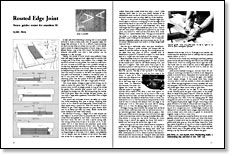
Synopsis: John Harra developed a system for edge-joining pieces of wood using a router, several clamps, a jig, a ruler, and a fence. The results are consistently near perfect, and, with a little practice, can be achieved in a few minutes, he says. His system can be used to match two pieces with S-curves or irregular compound curves, as well as straight pieces. Harra explains which bits to use, how to rest the jig, how to mark the wood, and how to commence cutting.
A basic task of woodworking is joining two or more pieces of wood to make a wide piece, with no apparent seam, for things like tabletops. It can be a difficult, time-consuming job and one that does not always turn out well. I have developed a system for edge-joining pieces of wood using a router, several clamps, a jig, a ruler and a fence. The results are consistently near-perfect and, with a little practice, can be achieved in a few minutes.
Ideally, two pieces of wood would mate perfectly if they were held edge-to-edge and both edges were cut smooth with a single pass of the router. Any variation from a straight line would be mirrored on both pieces. The router is a most versatile tool, but even at 22,000 rpm it isn’t powerful enough to cut that way. My system uses a fence to guide the router along the edge of the first piece to be joined; then the second piece is clamped facing the first and routed against the same fence. Thus any bumps or hollows in the fence are imparted to the first piece and transferred in reverse to the second piece. A hill in one piece will have a corresponding valley in the adjoining piece. The two pieces of wood are perfect mirror images and when joined, look like a single piece of wood.
This router system of edge-to-edge lumber joining can be used to match two pieces with “S” curves or irregular compound curves, as well as straight pieces, as long as the curves are gentle. Thus beautiful grain patterns don’t have to be disrupted by straight-line cuts. By joining along the natural flow of the grain, rather than through the grain pattern, you can build a large table apparently constructed from a single piece of wood.
The species and thickness of wood are really not critical. I’ve routed everything from pine to ebony. Anything from 1/4 in. to 2 in. thick can be routed easily. I have routed 3-in. thick maple using a special bit. With soft woods it is more difficult to get a clean edge because the grain doesn’t shear and cut as easily and often rips away. Harder woods have more resistance and break away cleanly.
More on FineWoodworking.com:
- Compound-Angle Joinery – Careful tenon layout is the key to cutting and mastering this intimidating joint
- Simple Cabinetry with Pocket Hole Joinery – Low-cost jig produces basic cabinetry joinery that’s easy and strong
- Address labels highlight layout marks on dark woods
From Fine Woodworking #9
For the full article, download the PDF below:
Fine Woodworking Recommended Products

Starrett 4" Double Square

Freud Super Dado Saw Blade Set 8" x 5/8" Bore

Pfiel Chip Carving Knife






















Log in or create an account to post a comment.
Sign up Log in